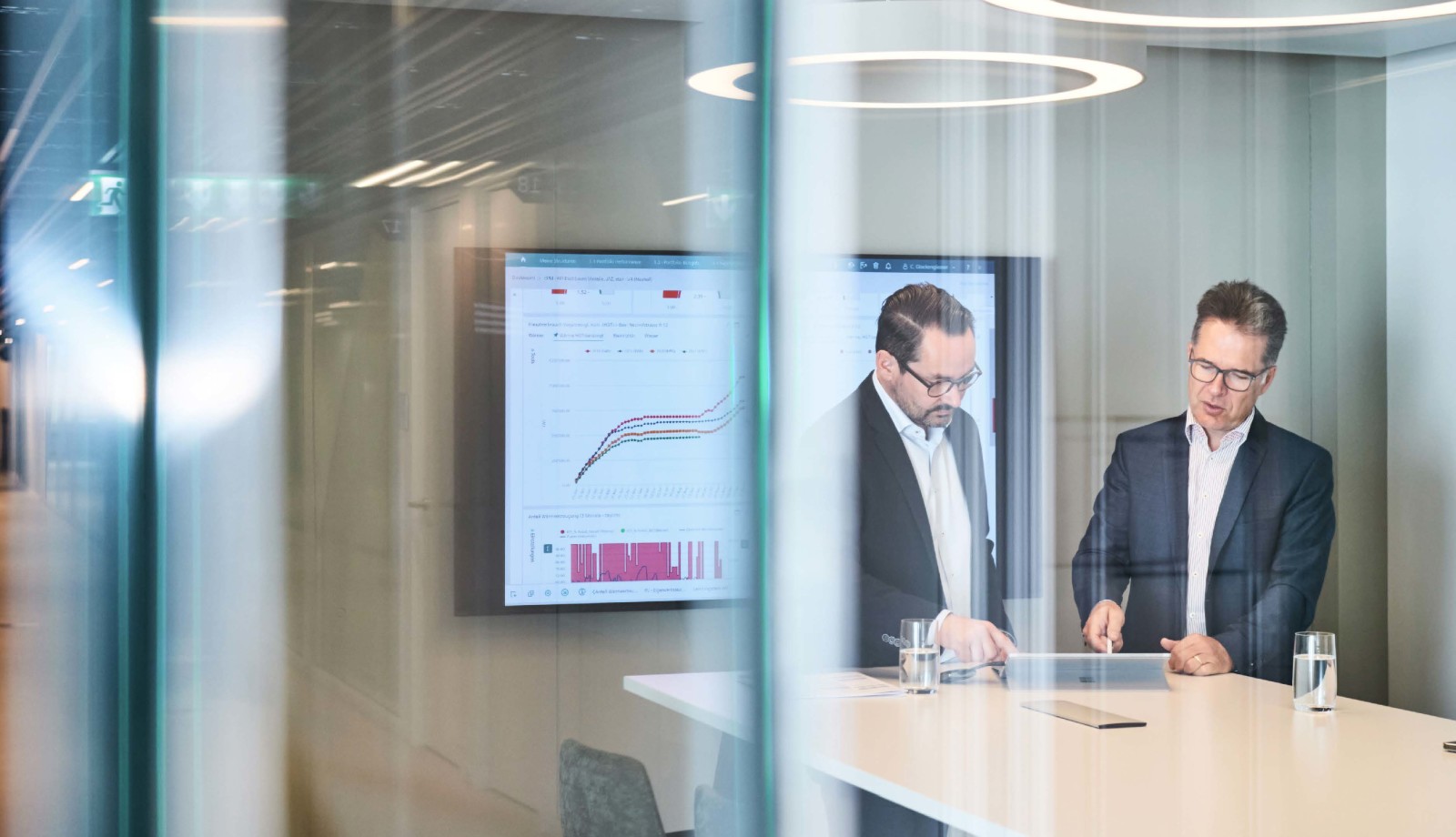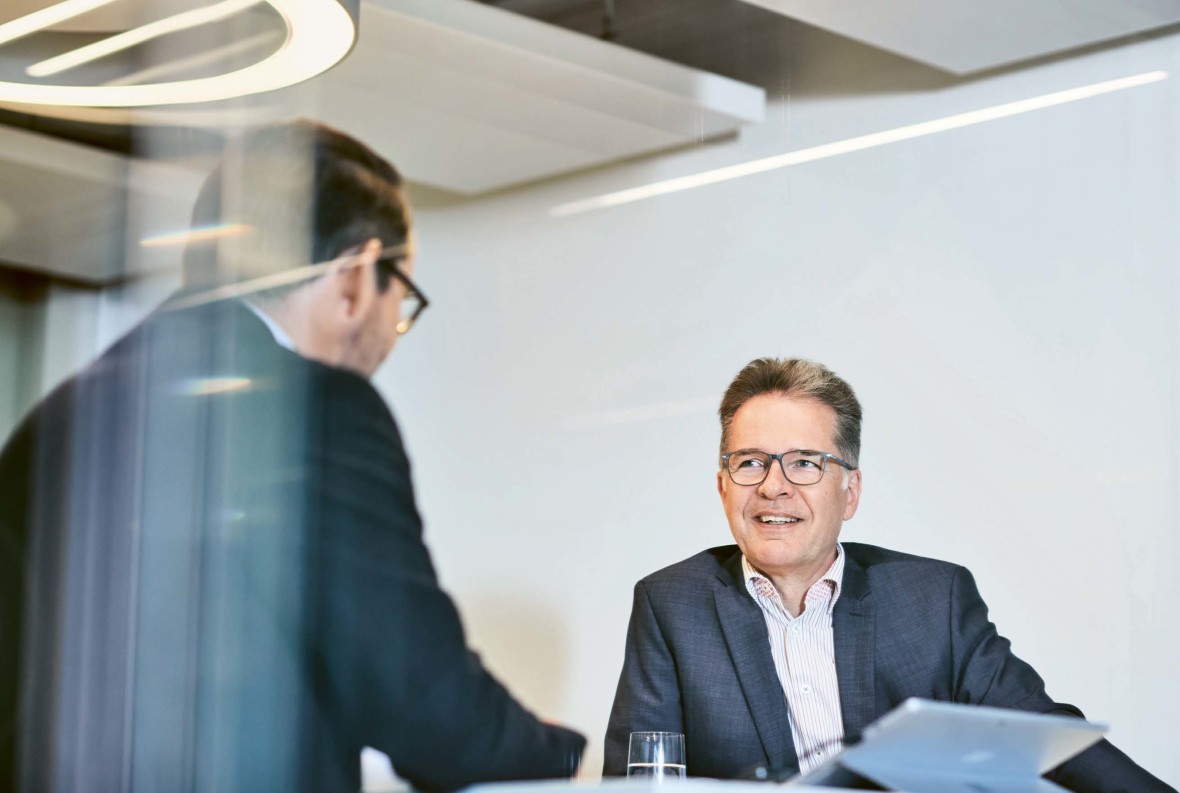
Careful use of resources
Energy accounts for approximately 45 percent of a building's life cycle costs – the balance between construction and dismantling. Optimising energy consumption is worthwhile, both for the environment and our wallets. Christoph Müller and Christoph Glockengiesser demonstrate how sustainability is implemented at Alfred Müller AG and explain the part that energy monitoring plays in this.
Has there been a change of thinking in terms of resources used in the construction of apartments and commercial spaces?
Christoph Müller: Yes, the careful use of resources is very topical, and we endeavour to ensure that our buildings consume as little energy as possible and cause minimal emissions. For every one of our building projects, we now clarify the question of finding the best and most sustainable energy supply. There are also various other points that we have to take into account, such as legislators' requirements.
Does making careful use of resources reflect a customer need? Have tenants and buyers become more sensitive about the issue of energy efficiency?
Christoph Müller: We do note that people are more environmentally aware. Low energy consumption and emissions are a welcome plus, but not our clients' top priority. Location, floor plan and price remain paramount.
How do sustainability considerations influence building? Are there materials or systems that are no longer used?
Christoph Glockengiesser: We're bang in the middle of a transition phase. These days, new buildings do without night storage heaters, oil or gas heating systems. A great deal has changed in the building sector, and resource-saving solutions are available in all areas. In our Quadrolith offices in Baar, for example, we have installed a hybrid system featuring energy piles that enable us to heat or cool the building with renewables.
Christoph Müller: In any building, several factors always come into play. In the case of materials, it isn't merely a matter of bearing in mind the energy used for the production of a structural element or raw material. The building's entire life cycle is important. Façades, for example, should provide good insulation, but also be durable. If they require little maintenance, it's good for the overall energy balance. From that point of view, a variety of materials are justified.
"Energy efficiency won’t be sweated for in the summer and frozen for in the winter."
What does it take for a building to become energy efficient? Does the architecture itself have an influence?
Christoph Müller: Yes, but the building must also reflect the client's wishes and needs. An office building with very good insulation but only very small windows will attract little interest. We need to find the balance between "aesthetic, modern" on the one hand and "energy efficient" on the other.
Christoph Glockengiesser: Successful architecture always takes into account several factors, such as how the building sits on its site or how convenient its traffic connections are. In terms of energy, additional questions are raised: How is the south-facing façade oriented and designed? Are there building components that minimise the sunlight entering the building in summer as much as possible while at the same time making it appear open and transparent? Can sunlight enter the building in the winter to reduce the amount of artificial light required and exploit the solar heat source?
At Alfred Müller AG, energy monitoring is key to implementing sustainability: you use this system to monitor and optimise energy consumption in office buildings. How does it work?
Christoph Müller: We equip all the buildings in our portfolio – and if desired also for third parties – with water, gas, heat, district heating and electricity meters. Consumption data is recorded at 15-minute intervals. To optimise consumption, it is important to analyse the data, learn lessons from it and take action.
Christoph Glockengiesser: An energy-efficient building provides just the amount of energy that users need to feel comfortable. That means, for example, that the temperature should be pleasant when people start working on a Monday morning. It should stay that way until the evening. The heating can, however, be switched off as early as 4 pm if the building is appropriately insulated. The ventilation system can also be shut down if fewer people are in the building after 5 pm and they don't need much ventilation. The building must react to very different situations in a needs-oriented manner. To achieve the highest possible degree of energy efficiency, the systems in the building must be well regulated and the efficiency of the equipment must be continuously monitored.
Which key figures must be considered to achieve optimisation?
Christoph Glockengiesser: The specific energy consumption – in other words, the energy consumed per square metre – is an important indicator. This ratio enables us to compare buildings or similar usages with one another. In a new building, we are also able to verify whether a system's consumption or efficiency when operating meets its planning specifications. If they do not, rectifications will be necessary until the objectives have been met.
"For every one of our building projects, we clarify the question of finding the best and most sustainable energy supply."
Does energy monitoring also have a positive effect in terms of reducing CO2 emissions?
Christoph Müller: Yes, it does. Monitoring primarily serves the purpose of optimising the entire system and reducing consumption. If consumption drops, this has the positive effect of both lowering ancillary costs and reducing CO2 emissions.
In terms of energy consumption, what would be your ideal house?
Christoph Müller: I would turn it round. We construct buildings that meet as wide a variety of requirements as possible, are appropriate to their location, have a good price-performance ratio, offer a high working and housing quality – as well as optimising consumption. Spaces full of life are created by optimising as many factors as possible.
Christoph Glockengiesser: In my opinion, the ideal house is built and operated with a minimum of resources. In future, buildings will even produce more energy than they consume. What's more, houses like that will offer an indoor climate in which their inhabitants feel comfortable all year round. Energy efficiency won't have to be achieved by sweating in the summer and freezing in the winter. In a word, energy efficiency means having precisely the necessary amount of energy available at the right time.

